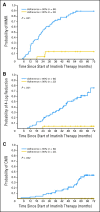Adherence is the critical factor for achieving molecular responses in patients with chronic myeloid leukemia who achieve complete cytogenetic responses on imatinib
- PMID: 20385986
- PMCID: PMC6366340
- DOI: 10.1200/JCO.2009.26.3087
Adherence is the critical factor for achieving molecular responses in patients with chronic myeloid leukemia who achieve complete cytogenetic responses on imatinib
Abstract
Purpose: There is a considerable variability in the level of molecular responses achieved with imatinib therapy in patients with chronic myeloid leukemia (CML). These differences could result from variable therapy adherence.
Methods: Eighty-seven patients with chronic-phase CML treated with imatinib 400 mg/d for a median of 59.7 months (range, 25 to 104 months) who had achieved complete cytogenetic response had adherence monitored during a 3-month period by using a microelectronic monitoring device. Adherence was correlated with levels of molecular response. Other factors that could influence outcome were also analyzed.
Results: Median adherence rate was 98% (range, 24% to 104%). Twenty-three patients (26.4%) had adherence <or= 90%; in 12 of these patients (14%), adherence was <or= 80%. There was a strong correlation between adherence rate (<or= 90% or > 90%) and the 6-year probability of a 3-log reduction (also known as major molecular response [MMR]) in BCR-ABL1 transcripts (28.4% v 94.5%; P < .001) and also complete molecular response (CMR; 0% v 43.8%; P = .002). Multivariate analysis identified adherence (relative risk [RR], 11.7; P = .001) and expression of the molecular human organic cation transporter-1 (RR, 1.79; P = .038) as the only independent predictors for MMR. Adherence was the only independent predictor for CMR. No molecular responses were observed when adherence was <or= 80% (P < .001). Patients whose imatinib doses were increased had poor adherence (86.4%). In this latter population, adherence was the only independent predictor for inability to achieve an MMR (RR, 17.66; P = .006).
Conclusion: In patients with CML treated with imatinib for some years, poor adherence may be the predominant reason for inability to obtain adequate molecular responses.
Conflict of interest statement
Authors' disclosures of potential conflicts of interest and author contributions are found at the end of this article.
Figures



Comment in
-
Medication Adherence to Tyrosine Kinase Inhibitors: 2-Year Analysis of Medication Adherence to Imatinib Treatment for Chronic Myeloid Leukemia and Correlation with the Depth of Molecular Response.Acta Haematol. 2016;136(1):45-51. doi: 10.1159/000444626. Epub 2016 May 10. Acta Haematol. 2016. PMID: 27160310
References
-
- Goldman JM, Melo JV: Chronic myeloid leukemia: Advances in biology and new approaches to treatment N Engl J Med 349: 1451– 1464,2003. - PubMed
-
- Druker B Guilhot F O'Brien S , etal : Five-year follow-up of imatinib therapy for newly diagnosed chronic myelogenous leukemia in chronic-phase shows sustained responses and high overall survival N Engl J Med 355: 2408– 2417,2006. - PubMed
-
- de Lavallade H Apperley JF Khorashad JS , etal : Imatinib for newly diagnosed patients with chronic myeloid leukemia: Incidence of sustained responses in an intention-to-treat analysis J Clin Oncol 26: 3358– 3363,2008. - PubMed
-
- Lin F Chase A Bungey J , etal : Correlation between the proportion of Philadelphia chromosome-positive metaphase cells and levels of BCR-ABL mRNA in chronic myeloid leukaemia Genes Chromosomes Cancer 13: 110– 114,1995. - PubMed
Publication types
MeSH terms
Substances
LinkOut - more resources
Full Text Sources
Other Literature Sources
Medical
Miscellaneous

